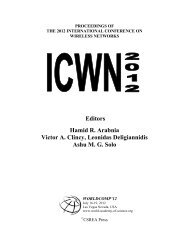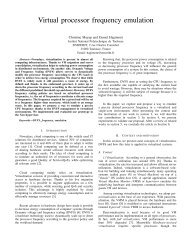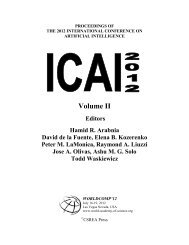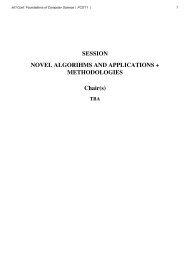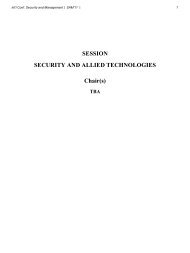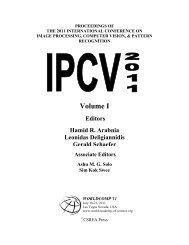SESSION GRAPH BASED AND TREE METHODS + RELATED ...
SESSION GRAPH BASED AND TREE METHODS + RELATED ...
SESSION GRAPH BASED AND TREE METHODS + RELATED ...
- TAGS
- graph
- methods
- world-comp.org
Create successful ePaper yourself
Turn your PDF publications into a flip-book with our unique Google optimized e-Paper software.
46 Int'l Conf. Foundations of Computer Science | FCS'12 |<br />
3 NZMATH<br />
NZMATH[3] is a number theory oriented calculation<br />
system mainly developed by the Nakamula laboratory<br />
at Tokyo Metropolitan University. Number theoretic<br />
algorithms are implemented as Python functions on<br />
NZMATH, which is freely available and distributed<br />
under the BSD license. NZMATH is at an early stage<br />
of development and is currently being developed.<br />
4 Strategy of Formalizing Algorithms<br />
in Mizar<br />
In Mizar, there are several methods to define computational<br />
routines, representing algorithms. One method<br />
is to define a routine as a program for SCM. SCM is a<br />
general model of a stack machine defined in the Mizar<br />
system. In principle, we may formalize arbitrary programs<br />
in SCM. However, this approach may not be<br />
suitable to prove the accuracy of algorithms encoded<br />
in a high level programing language, because we have<br />
to define an algorithm as the machine code of SCM.<br />
For example, the Euclidean Algorithm has been formalized<br />
in SCM[4] (Definition A.1).<br />
Another method is to define a routine as a functor or<br />
a Function. A functor is a relation between input and<br />
output of the routine in Mizar. It is easy to write and<br />
understand the formalization of a routine as functor<br />
because the format of a functor in Mizar is similar to<br />
that of a function in programming languages. Thus,<br />
in this paper, we formalize an algorithm as a functor.<br />
A Function is a map from the input space onto the<br />
output space. We can handle a Function as an element<br />
of the set of Functions. Note that both functor<br />
and Function can use a Function as their substitutable<br />
subroutine. For example, we formalized the algorithm<br />
of DES cipher as a functor, which uses substitution<br />
subroutines defined as Functions[5, 6].<br />
4.1 Formalizing Loop Structure in Mizar<br />
In this section, we propose an approach to describe<br />
programs with a loop structure. Particularly, we elucidate<br />
the method to formalize programs with a nonnested<br />
loop structure 1 . This suggests that it is possible<br />
to formalize a program with looped structures by<br />
nesting single loop structures recursively.<br />
A loop is a sequence of statements. In a computer<br />
implementation, variables that are allocated memory<br />
segments, are assigned destructively according to the<br />
given recursion formula in each iteration.<br />
To describe the loop structure in the Mizar language,<br />
we consider that there are sequences of variables<br />
to capture the repetition of operations. For example,<br />
let a be the sequence of variables such that ai,<br />
the ith member of a, represents the temporary value<br />
assigned as a in the ith iteration of the loop structure.<br />
Note that we can describe the control condition of the<br />
1 Note that all algorithms, which were formalized in this pa-<br />
per, do not have nested loops.<br />
iteration using the index number of the sequences of<br />
variables.<br />
We can employ the inductive method to prove<br />
the property of the variables using such sequences.<br />
The Mizar system has a mechanism, called “scheme”,<br />
which enables us to prove propositions using the inductive<br />
method. We will show an example of a proof<br />
using “scheme” in Section 5.<br />
5 Formalization of the Euclidean<br />
Algorithm<br />
In this section we introduce our formalization of the<br />
Euclidean algorithm.<br />
The Euclidean algorithm is a the method that computes<br />
the greatest common divisor of two given integers.<br />
This algorithm is implemented in NZMATH as<br />
follows:<br />
Code 5.1 (Euclidean algorithm in NZMATH)<br />
def gcd(a, b):<br />
a, b = abs(a), abs(b)<br />
while b:<br />
a, b = b, a % b<br />
return a<br />
We formalize this algorithm as the following functor<br />
in the Mizar language:<br />
Definition 5.1 (Euclidean Algorithm in Mizar)<br />
let a,b be Element of INT;<br />
func ALGO_GCD(a,b)<br />
-> Element of NAT<br />
means<br />
ex A,B be sequence of NAT<br />
st<br />
A.0 = abs(a) & B.0 = abs(b) &<br />
(for i be Element of NAT holds<br />
A.(i+1) = B.i &<br />
B.(i+1) = A.i mod B.i) &<br />
it = A.(min*{i where i is Nat: B.i = 0});<br />
Here the symbol ‘it’ denotes the value returned by<br />
the functor. min* is the definition of the minimum<br />
member of a given set in Mizar (Definition A.2). A<br />
and B are infinite sequences of N such that<br />
A = {a0, a1, . . . , ai, ai+1, . . .},<br />
B = {b0, b1, . . . , bi, bi+1, . . .},<br />
a0 = a, b0 = b,<br />
ai+1 = bi, bi+1 = ai mod bi.<br />
Note that ai, bi are the values of a, b in the ith iteration,<br />
respectively.



